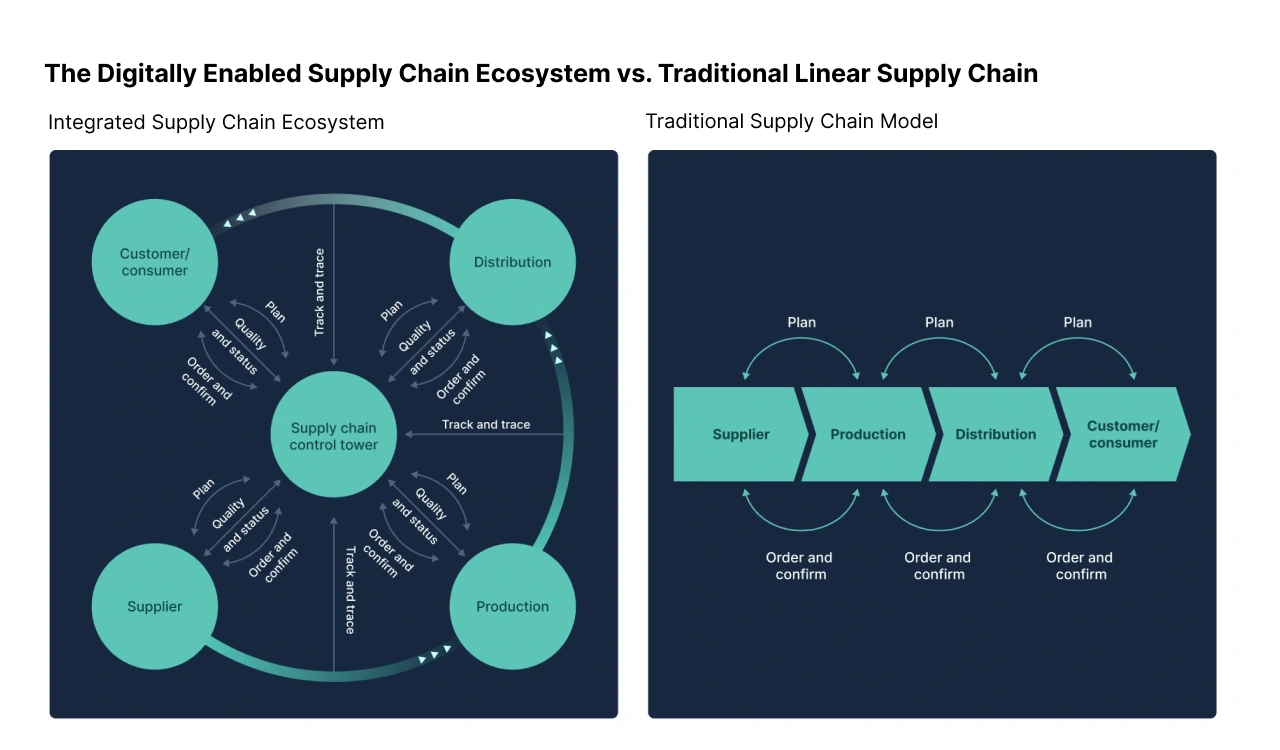Supply Chain Digitization
- Introduction
- What is Supply Chain Digitization?
- Are Traditional Supply Chains Falling Behind in Today’s Digital World?
- How Can Companies Achieve Supply Chain Digitization?
- 4 Advantages of Supply Chain Digitization for Businesses
- 2 Ways Supply Chain Digitization Helps Businesses Address the Requirements of New-Age Customers
- Book a Session!

Supply chain digitization is the process of bringing together accurate data points and processes under one unified platform. Digitization provides end-to-end visibility, enhances supply chain performance, resilience and ensures that different supply chain tools integrate seamlessly.
As such, digitization is no longer a first-mover advantage but an industry standard. For instance, Deloitte’s 2024 Manufacturing Industry Outlook marks the need for manufacturers to embrace supply chain digitization, deeming it essential for tackling ongoing manufacturing challenges.
Find out more: How Syren Helps Manufacturing Companies Overcome Pain Areas & Achieve KPIs
This article explores digital transformation in supply chains in detail, outlines the key benefits of digitization for businesses, end-customers and much more.
What is Supply Chain Digitization?
Supply chain digitization, sometimes also referred to as supply chain digitalization or supply chain digital transformation , is the process of replacing all manual and analog procedures with digital solutions in the supply chain.
This is achieved through establishing a dedicated master database that aggregates data points collected from:
- a. Across different stages of the supply chain.
- b. Sales: Historical sales data, Point-of-sale consumer data, etc.
- c. Socioeconomic sources: Unemployment rates, etc.
- d. External sources: Google trends, Competitor prices, etc.
It enables companies to incorporate digital products and services into different aspects of their supply chain to:
- a. Streamline/automate operations
- b. Improve management
- c. Increase visibility
- d. Enhance resilience, etc.
According to a recent PwC study on the rise of Industry 4.0, a third of the more than 2,000 respondents say their companies have started to digitize their supply chains. The reasons behind the investment rush are easy to see.
Supply chain professionals expect digitization to bring significant economic benefits to both top and bottom lines: Companies with highly digitized supply chains and operations can expect efficiency gains of 4.1 percent annually, while boosting revenue by 2.9 percent a year.*
*A 2016 forecast
Are Traditional Supply Chains Falling Behind in Today’s Digital World?
Traditional vs. Digital Supply Chains: Comparison Table
| Feature | Traditional Supply Chains | Digital Supply Chains |
|---|---|---|
| Technology Systems | Use standalone systems | Use integrated technology systems that work seamlessly together |
| Data Utilization | Rely on historical inputs | Leverage real-time information updated automatically |
| Transparency | Limited, due to silos | Enhanced, creating better transparency between different players |
| Response to Changes | Slower, due to reliance on historical data | Faster, allowing for timely responses to spot issues or risks |
| Lead Times | Longer, due to manual physical processes | Shorter, thanks to digital warehousing and advanced management systems |
| Warehousing Solutions | Primarily manual and physical processes | Includes smart warehousing solutions like wearables and automated guided vehicles |
| Risk Management | Reactive, based on past experiences | Proactive, with the ability to anticipate and mitigate risks in real-time |
| Communication | Information delayed as it moves through each organization | Information available to all supply chain members simultaneously |
| Collaboration | Limited visibility to the entire chain, hindering meaningful collaboration | Natural development of collaboration depth to capture intrinsic supply chain value |
| Flexibility | End customer demand distorted as information flows along the material path | End customer demand changes are rapidly assessed |
Read More: What are the Challenges of Implementing AI into Supply Chains?
How Can Companies Achieve Supply Chain Digitization?
Supply chain digitization is primarily achieved through software implementation that enables automation and business intelligence solutions.
Syren Cloud offers a suite of advanced supply chain analytical and visibility solutions that aid companies in seamless digitizing their supply chains. Syren Cloud’s S3C, short for Supply Chain Command Center, is a unified platform that enables companies to achieve:
- 1. 360-degree, real-time supply chain visibility
- 2. Holistic integration with internal and external ERPs
- 3. Access to a centralized hub of data, BI reports and dashboards
- 4. Deep insights with Cognitive AI
- 5. Effortless interaction with data powered by NLP
Read More: Learn How to Enhance Your Supply Chain with a Cognitive Command Center
End-to-end Supply Chain Visibility
From suppliers to logistics teams, Syren’s S3C provides a comprehensive overview of every element in your supply chain. You can zoom into the procurement process and track orders, monitor supplier performance, and ensure timely raw material delivery. Or, find out your inventory status, holding costs and much more with a single tap.

Effortless ERP Integration
The S3C integrates with ERP systems of your vendors and other middlemen seamlessly. It also onboards data from other external sources like WMS, POS, etc without any manual intervention. All this information is streamlined and stored along with the data gathered through internal ERPs.
This streamlined data is used to provide detailed information and end-to-end visibility into all stages of the supply chain – Procurement, Inventory, Manufacturing, Sales & Operations, and finally, Transportation & Logistics.
Centralized Data Hub as the Single Source of Truth
The data gathered from multiple sources is cleaned and stored in a centralized hub that can easily be accessed by stakeholders. This eliminates data inconsistencies, misinterpretation, complexities and seamlessly fosters cross-team collaboration across different stages of the supply chain. All reports and dashboards can be accessed with just a few clicks on the centralized hub.
LLM-Powered Supply Chain Insights and Recommendations
With the power of cognitive AI, S3C can process and analyze vast amounts of data. The system processes this data through advanced solutions like ATP, OTIF, CTD, etc., and gives out powerful insights and recommendations. It offers deeper insights into the supply chain, predicting disruptions, and suggesting optimal mitigative solutions to counter challenges.
The recommendations are based on real-time updates in market trends, changing demands and much more. Reports generated consist of a wide range of insights such as cost savings, slow moving objects in the inventory, CO2 emissions, etc. which are crucial for precision decision making.
Natural Language Query-Based Communication With Data
There is no formal training required for using the S3C. All stakeholders can gain insights and recommendations relevant for each supply chain scenario through a simple chat with the system.
It could be the most efficient route of transportation, the amount of inventory you are holding at different warehouses or the carrying costs you are currently incurring, send queries in natural language and instantly access insights, generate BI dashboards, reports, plots and much more.
4 Advantages of Supply Chain Digitization for Businesses

Better Financial Management
Real-time visibility enables companies to acutely understand inventory activity, supplier performance, machine downtime and much more. This directly translates to improved financial management.
For instance, with Syren Cloud, you can automate sending replenishment requests when it’s time to refill your inventory. This helps avoid stockouts, reduces the risk of overstocking and dead stocks.
Minimized Lead Times
Businesses with a 360-degree overview of their supply chains can build effective strategies to increase supply chain velocity and minimize lead times. This requires consistent collaboration between all departments of the company, suppliers, and retailers. Digitization eliminates the manual work across teams and helps speed up different processes.
Read More: Explore the Power of Lead Time Reduction in Supply Chains
Improved Decision Making
Advanced supply chain analytical and visibility solutions like Syren Cloud Supply empower businesses to make data-driven business decisions. For instance, it can help analyze historical sales, consumer buying behavior and much more to generate sales predictions and optimal marketing strategies. This inturn enables you to plan your inventory distribution, maintain accurate stock levels and reduce expenses.
Ensure Quality and Compliance During Supplier Diversification
Recent geopolitical tensions like tariffs imposed in the U.S.-China trade dispute or shutdowns during the pandemic forced businesses to source from unfamiliar geographies. In this process, several organizations have faced operational complexities and risks; especially related to supplier performance and raw material quality.
Businesses with highly digitized supply chains can quickly minimize concerns of supplier assessment and management. Companies can easily assess suppliers based on their credit ratings, on-time delivery performance, order fulfillment rate, etc.
Read More: Learn How the Semiconductor Shortage Affected the Automotive Industry
2 Ways Supply Chain Digitization Helps Businesses Address the Requirements of New-Age Customers
Supply chain digitization, helps companies solve the challenges on the supply side as well as manages consumer expectations in terms of supply chain efficiency.
Shorter delivery timelines
The basis of new-age supply chains is built on advanced approaches such as predictive analytics.
Predictive analytics helps accurately forecast demand based on internal factors like demand and external factors like market trends, weather conditions, etc, machine status data and much more. This helps companies in effectively communicating with their customers about the exact delivery timelines and ensure a smooth shopping experience.
Interestingly, Amazon holds a patent for ‘anticipatory shipping’ wherein products are shipped before the customer places an order. The customer order is later on matched with a shipment that is already in the logistics network and the shipment is rerouted to the exact customer destination.
Read More: Revolutionizing Logistics Supply Chains: A New Model for Success
Quickly Adapt to Fluctuating Demand
Real-time planning minimizes frozen periods. It becomes a continual process which helps businesses react dynamically as per constraints and evolving requirements. Businesses can tie up with supply chain analytics providers like Syren Cloud and increase their adaptability quotient.
The data points gathered from all stages and vendors in your supply chain are processed through advanced analytics and KPIs like Available to Promise (ATP), On Time In Full (OTIF), Cost to Deliver (CTD), etc. allow you to improve customer service and rightly cater to the demand.
The integration of data of suppliers, service providers, etc. in a supply chain cloud ensures that all stakeholders steer business decisions in the right direction.


